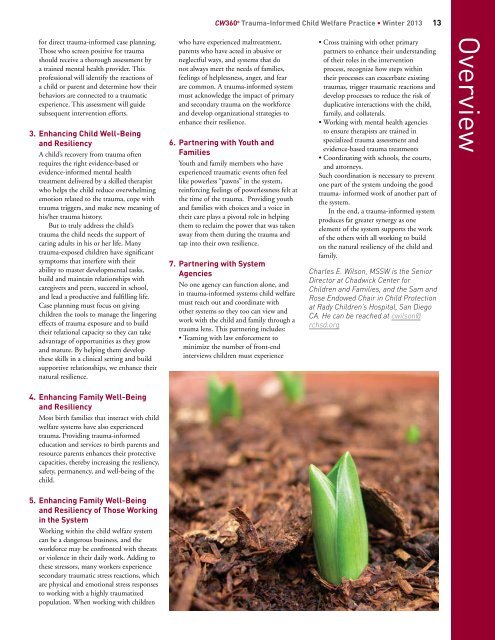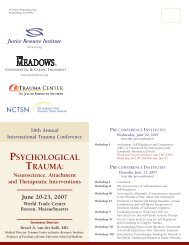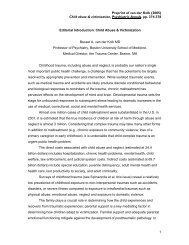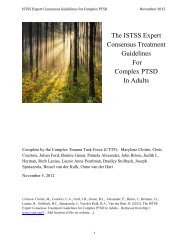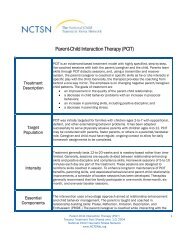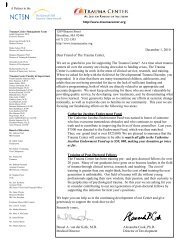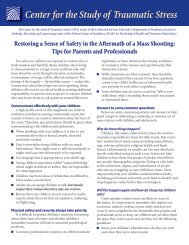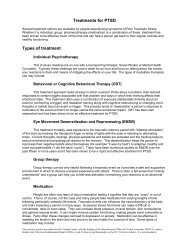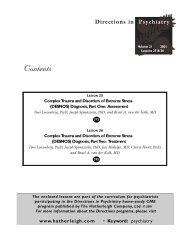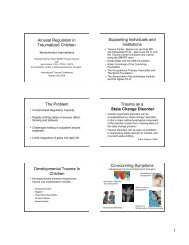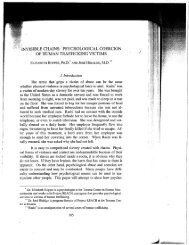12 CW360 o <strong>Trauma</strong>-Informed <strong>Child</strong> <strong>Welfare</strong> Practice • W<strong>in</strong>ter 2013<strong>The</strong> Emergence of <strong>Trauma</strong>-Informed <strong>Child</strong> <strong>Welfare</strong> SystemsCharles E. Wilson, MSSWOverviewOver the last 30 years, society’s understand<strong>in</strong>gof the effects of traumatic stress has <strong>in</strong>creasedsignificantly and more recently we have begunto recognize the <strong>in</strong>teraction between traumaticstress and the service systems we put <strong>in</strong> placeto support vulnerable populations. Nowhereis this connection between trauma and thesystem more strik<strong>in</strong>g than <strong>in</strong> the nation’s childwelfare systems. Almost all children servedby the child welfare system report chronicand complex trauma histories, complicatedby system-imposed stresses such as removaland multiple foster care placements. <strong>Child</strong>renwith such experiences often require supportof a skillful and well tra<strong>in</strong>ed mental healthprofessional, but treatment alone is notenough. Over the last six years, it has becomeclear to many work<strong>in</strong>g <strong>in</strong> the National <strong>Child</strong><strong>Trauma</strong>tic Stress Network 1 (NCTSN) thatmean<strong>in</strong>gful treatment of children <strong>in</strong> thechild welfare system must be matched withsystem supports. Essentially, the entire childwelfare system needs to be transformed <strong>in</strong>to a“trauma-<strong>in</strong>formed system.”What is a trauma-<strong>in</strong>formed system?<strong>The</strong> term first appeared <strong>in</strong> substance abuseliterature to recognize that many seriouslyaddicted <strong>in</strong>dividuals had experienced majortraumas, and those traumatic events hadshaped their lives <strong>in</strong> sometimes disastrousways (see Conradi & Wilson, 2010 for a fullreview of this topic). By 2004, NCTSN wasapply<strong>in</strong>g similar concepts to child traumavictims and that work led to a variety ofproducts and services developed with<strong>in</strong>the Network. One def<strong>in</strong>ition of a trauma<strong>in</strong>formedsystem has been advanced by theChadwick <strong>Trauma</strong>-Informed Systems Project(CTISP), with support of a national advisorycommittee. CTISP def<strong>in</strong>es a trauma-<strong>in</strong>formedchild welfare system as a system “<strong>in</strong> which allparties <strong>in</strong>volved recognize and respond to thevary<strong>in</strong>g impact of traumatic stress on children,caregivers and those who have contact with thesystem. Programs and organizations with<strong>in</strong> thesystem <strong>in</strong>fuse this knowledge, awareness andskills <strong>in</strong>to their organizational cultures, policies,and practices. <strong>The</strong>y act <strong>in</strong> collaboration, us<strong>in</strong>gthe best available science, to facilitate andsupport resiliency and recovery” (Chadwick<strong>Trauma</strong>-Informed Systems Project, 2011).<strong>The</strong>re are key phrases <strong>in</strong> this def<strong>in</strong>itionthat are worth po<strong>in</strong>t<strong>in</strong>g out. First, thedef<strong>in</strong>ition applies to the wider child welfaresystem not just the public child welfareagency. Second, the def<strong>in</strong>ition focuses notonly on child trauma victims but also theircaregivers and the workforce who seek tosupport them. All three of these groupsare affected by traumatic events, <strong>in</strong>clud<strong>in</strong>gprimary traumatic experiences that threatentheir own or their loved one’s lives or physical<strong>in</strong>tegrity as well as vicarious trauma fromwhat they see, hear, and experience whenwork<strong>in</strong>g <strong>in</strong>timately with traumatized children.<strong>The</strong> def<strong>in</strong>ition stresses the “vary<strong>in</strong>g impactof trauma,” <strong>in</strong>dicat<strong>in</strong>g that each child andadult is unique and reacts to trauma <strong>in</strong> hisor her own way. Some children and adultshave great resilience and may not requirecl<strong>in</strong>ical <strong>in</strong>tervention while others exposedto similar levels of trauma are devastatedand require skillful <strong>in</strong>tervention. <strong>The</strong>def<strong>in</strong>ition emphasizes that it is not enoughto be knowledgeable about trauma but alsoasserts that the system must act to makeuse of that knowledge by <strong>in</strong>tegrat<strong>in</strong>g it <strong>in</strong>toeveryday <strong>in</strong>teractions with families and theirorganizational cultures.To undertake this effort, the child welfaresystem needs a framework, and the NCTSNoffers one <strong>in</strong> its “Essential Elements of atrauma-<strong>in</strong>formed child welfare system.”<strong>The</strong> NCTSN <strong>Child</strong> <strong>Welfare</strong> Committeeis currently <strong>in</strong> the process of ref<strong>in</strong><strong>in</strong>g theessential elements, first <strong>in</strong>troduced <strong>in</strong> 2006.What emerges are the follow<strong>in</strong>g sevenessential elements (<strong>Child</strong> <strong>Welfare</strong> Committee,personal communication, March 7, 2012).1. Maximize Physical andPsychological Safety for the<strong>Child</strong> and FamilyWhile child welfare has always had a focuson physical safety, a trauma-<strong>in</strong>formedsystem must go further and recognizethat psychological safety is importantto the child’s long-term recovery andsocial and emotional well-be<strong>in</strong>g and hasdirect implications for physical safetyand permanence. Psychological safety isa sense of safety or the ability to feel safewith<strong>in</strong> one’s self and safe from externalharm and is critical for function<strong>in</strong>g aswell as physical and emotional growth.A lack of psychological safety can impactchildren’s <strong>in</strong>teractions with all other<strong>in</strong>dividuals, <strong>in</strong>clud<strong>in</strong>g those try<strong>in</strong>g tohelp them, and can lead to a variety ofmaladaptive strategies for cop<strong>in</strong>g withthe anxiety associated with feel<strong>in</strong>g unsafe.<strong>The</strong>se “survival strategies” often <strong>in</strong>cludea range of symptoms and behaviorsfrom substance abuse to self-mutilation.<strong>Child</strong>ren and/or adults may cont<strong>in</strong>ue tofeel psychologically unsafe long after thephysical threat has been removed or theyhave been relocated to a physically safeenvironment, such as a relative or fosterhome.<strong>The</strong> system should offer universal screen<strong>in</strong>g for traumatic historyand traumatic stress responses, which will assist the workers <strong>in</strong>understand<strong>in</strong>g the history of a child or family.Even after the child or adults ga<strong>in</strong>ssome degree of security, people, places,and events may unexpectedly rem<strong>in</strong>d themof past traumas and draw their attentionback to <strong>in</strong>tense and disturb<strong>in</strong>g memoriesoverwhelm<strong>in</strong>g their ability to cope aga<strong>in</strong>.At times, a seem<strong>in</strong>gly <strong>in</strong>nocuous eventor sensory stimuli such as smells, sights,sounds, touches, or objects may triggersubconscious rem<strong>in</strong>ders of the traumathat produce a strong physiologicalresponse where<strong>in</strong> the biochemical systemsof the body react as if the trauma werehappen<strong>in</strong>g aga<strong>in</strong>. A trauma-<strong>in</strong>formedchild welfare system understands thatthese pressures may help to expla<strong>in</strong> achild or parent’s behavior and can use thisknowledge to help them better managetriggers and to feel safe.2. Identify <strong>Trauma</strong>-Related Needsof <strong>Child</strong>ren and Families<strong>The</strong> child welfare workforce should beeducated on trauma and how it affects an<strong>in</strong>dividual at any stage of developmentand <strong>in</strong>tersects with his/her culture. <strong>The</strong>system should offer universal screen<strong>in</strong>gfor traumatic history and traumatic stressresponses, which will assist the workers<strong>in</strong> understand<strong>in</strong>g the history of a child orfamily. <strong>The</strong> screen<strong>in</strong>g will help identifypotential triggers and will create a guide1Established by Congress <strong>in</strong> 2000, the National <strong>Child</strong> <strong>Trauma</strong>tic Stress Network (NCTSN) is a unique collaboration of academic and communitybasedservice centers whose mission is to raise the standard of care and <strong>in</strong>crease access to services for traumatized children and theirfamilies across the United States.
CW360 o <strong>Trauma</strong>-Informed <strong>Child</strong> <strong>Welfare</strong> Practice • W<strong>in</strong>ter 2013 13for direct trauma-<strong>in</strong>formed case plann<strong>in</strong>g.Those who screen positive for traumashould receive a thorough assessment bya tra<strong>in</strong>ed mental health provider. Thisprofessional will identify the reactions ofa child or parent and determ<strong>in</strong>e how theirbehaviors are connected to a traumaticexperience. This assessment will guidesubsequent <strong>in</strong>tervention efforts.3. Enhanc<strong>in</strong>g <strong>Child</strong> Well-Be<strong>in</strong>gand ResiliencyA child’s recovery from trauma oftenrequires the right evidence-based orevidence-<strong>in</strong>formed mental healthtreatment delivered by a skilled therapistwho helps the child reduce overwhelm<strong>in</strong>gemotion related to the trauma, cope withtrauma triggers, and make new mean<strong>in</strong>g ofhis/her trauma history.But to truly address the child’strauma the child needs the support ofcar<strong>in</strong>g adults <strong>in</strong> his or her life. Manytrauma-exposed children have significantsymptoms that <strong>in</strong>terfere with theirability to master developmental tasks,build and ma<strong>in</strong>ta<strong>in</strong> relationships withcaregivers and peers, succeed <strong>in</strong> school,and lead a productive and fulfill<strong>in</strong>g life.Case plann<strong>in</strong>g must focus on giv<strong>in</strong>gchildren the tools to manage the l<strong>in</strong>ger<strong>in</strong>geffects of trauma exposure and to buildtheir relational capacity so they can takeadvantage of opportunities as they growand mature. By help<strong>in</strong>g them developthese skills <strong>in</strong> a cl<strong>in</strong>ical sett<strong>in</strong>g and buildsupportive relationships, we enhance theirnatural resilience.who have experienced maltreatment,parents who have acted <strong>in</strong> abusive orneglectful ways, and systems that donot always meet the needs of families,feel<strong>in</strong>gs of helplessness, anger, and fearare common. A trauma-<strong>in</strong>formed systemmust acknowledge the impact of primaryand secondary trauma on the workforceand develop organizational strategies toenhance their resilience.6. Partner<strong>in</strong>g with Youth andFamiliesYouth and family members who haveexperienced traumatic events often feellike powerless “pawns” <strong>in</strong> the system,re<strong>in</strong>forc<strong>in</strong>g feel<strong>in</strong>gs of powerlessness felt atthe time of the trauma. Provid<strong>in</strong>g youthand families with choices and a voice <strong>in</strong>their care plays a pivotal role <strong>in</strong> help<strong>in</strong>gthem to reclaim the power that was takenaway from them dur<strong>in</strong>g the trauma andtap <strong>in</strong>to their own resilience.7. Partner<strong>in</strong>g with SystemAgenciesNo one agency can function alone, and<strong>in</strong> trauma-<strong>in</strong>formed systems child welfaremust reach out and coord<strong>in</strong>ate withother systems so they too can view andwork with the child and family through atrauma lens. This partner<strong>in</strong>g <strong>in</strong>cludes:• Team<strong>in</strong>g with law enforcement tom<strong>in</strong>imize the number of front-end<strong>in</strong>terviews children must experience• Cross tra<strong>in</strong><strong>in</strong>g with other primarypartners to enhance their understand<strong>in</strong>gof their roles <strong>in</strong> the <strong>in</strong>terventionprocess, recognize how steps with<strong>in</strong>their processes can exacerbate exist<strong>in</strong>gtraumas, trigger traumatic reactions anddevelop processes to reduce the risk ofduplicative <strong>in</strong>teractions with the child,family, and collaterals.• Work<strong>in</strong>g with mental health agenciesto ensure therapists are tra<strong>in</strong>ed <strong>in</strong>specialized trauma assessment andevidence-based trauma treatments• Coord<strong>in</strong>at<strong>in</strong>g with schools, the courts,and attorneys.Such coord<strong>in</strong>ation is necessary to preventone part of the system undo<strong>in</strong>g the goodtrauma- <strong>in</strong>formed work of another part ofthe system.In the end, a trauma-<strong>in</strong>formed systemproduces far greater synergy as oneelement of the system supports the workof the others with all work<strong>in</strong>g to buildon the natural resiliency of the child andfamily.Charles E. Wilson, MSSW is the SeniorDirector at Chadwick <strong>Center</strong> for<strong>Child</strong>ren and Families, and the Sam andRose Endowed Chair <strong>in</strong> <strong>Child</strong> Protectionat Rady <strong>Child</strong>ren’s Hospital, San DiegoCA. He can be reached at cwilson@rchsd.orgOverview4. Enhanc<strong>in</strong>g Family Well-Be<strong>in</strong>gand ResiliencyMost birth families that <strong>in</strong>teract with childwelfare systems have also experiencedtrauma. Provid<strong>in</strong>g trauma-<strong>in</strong>formededucation and services to birth parents andresource parents enhances their protectivecapacities, thereby <strong>in</strong>creas<strong>in</strong>g the resiliency,safety, permanency, and well-be<strong>in</strong>g of thechild.5. Enhanc<strong>in</strong>g Family Well-Be<strong>in</strong>gand Resiliency of Those Work<strong>in</strong>g<strong>in</strong> the SystemWork<strong>in</strong>g with<strong>in</strong> the child welfare systemcan be a dangerous bus<strong>in</strong>ess, and theworkforce may be confronted with threatsor violence <strong>in</strong> their daily work. Add<strong>in</strong>g tothese stressors, many workers experiencesecondary traumatic stress reactions, whichare physical and emotional stress responsesto work<strong>in</strong>g with a highly traumatizedpopulation. When work<strong>in</strong>g with children


